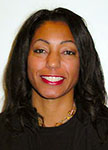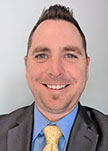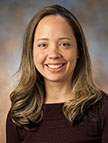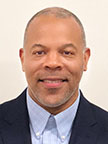
Mary Patton
Mary Patton says she did not have any “career skills” when Barbara Taylor, the instructor of the networking course she took her first semester at Collin College in Texas, suggested attending an info session about the convergence technology associate degree the college was starting with an Advanced Technological Education grant from the National Science Foundation.
“I really liked what I heard and I changed my major,” Patton says.
Choosing the degree program that blended the then-new voice over internet protocol with other information technology (IT) skills was one of several critical decisions Patton made in 2004. At the age of 30, she had left her abusive husband, quit her job as a casino waitress, moved with her two-year-old daughter in to her parents’ home in Frisco, Texas, and enrolled in the nearby community college. Her parents’ help included paying for her daughter’s daycare so she could concentrate on her coursework.
Since 2007 when she became the first graduate of the program developed by the Convergence Technology Center, Patton has excelled in her career. As a senior systems administrator for global messaging and collaboration team at IHS Markit, Patton recently earned a bonus for merging 17,000 users into a unified Lync environment.
Patton is one of five ATE program alumni who will be honored at the ATE Principal Investigators Conference that the American Association of Community Colleges, in partnership with the National Science Foundation, hosts next week in Washington, D.C., as part of the program’s 25th anniversary celebration.
ATE, the National Science Foundation’s (NSF) largest investment in two-year colleges, officially began in 1993 with a Federal Register announcement of the program that NSF developed in response to the 1992 Scientific and Advanced Technology Act. ATE is a competitive grant program that funds innovative technician education programs and research. Community college educators have leadership roles in ATE initiatives, which also include partnerships with employers in fields important to the nation’s economy and security.
In recent interviews, Patton (not related to the author of this article) and the other alumni who will participate in a panel at the conference talked about successfully navigating changes in their respective fields thanks to the knowledge and skills they gained in their ATE programs. Patton recalled that during one economic downturn she was laid off on a Monday and had a better job by Friday thanks to the foundational skills she learned at Collin and because she had heeded her instructors’ advice to educate herself about new technologies.
Bridge to Biotech leads to a dream job

Marlena Jackson
Genentech was “just a stone’s throw” from where Marlena Jackson lived in the Southeast section of San Francisco. The biotech company was where she hoped to put her bachelor’s degree in biology to work after several years of childrearing. However, she applied numerous times for jobs at Genentech without success.
Enrolling in the Bridge to Biotech certificate program facilitated the breakthrough Jackson needed to make her dream job a reality. The Next Generation National Advanced Technological Education Center of Excellence for Biotechnology and Life Sciences (Bio-Link) at City College of San Francisco in California created the Bridge to Biotech with ATE support.
“When I discovered the Bridge to Biotech program, I connected with a network of caring professors and industry professionals, who really supported me and helped me to make inroads into this space,” Jackson says.
She credits the hands-on laboratory skills the program teaches and the connections to employers it offers with helping her land an internship at Genentech in 2006. Her performance during the internship led to a full-time job.
After 12 years of working as a research scientist at Genentech, Jackson became a diversity talent partner at the company in 2018. In that role she focuses on attracting future talent.
Cultivating “hidden gems” of talent among female African-American and Latino high school students has long been an avocation of hers. In 2011, she created NexGeneGirls, which provides girls from low-income neighborhoods with mentoring, workshops and job shadowing experiences in academic laboratories to encourage their pursuit of STEM careers. Participants receive stipends, and several of the girls have completed more than 900 hours of hands-on, laboratory research.
A solid foundation in IT skills

James Gannage
James Gannage was 15 and had not completed the equivalent of sophomore year of high school in his home school curriculum when his parents proposed that he take the high school proficiency exam and enroll at Cuesta College in California.
About this time, his mom came home from her job as a dental hygienist with information from a patient about a new robotics program that the college was offering as a partner of the California Regional Consortium for Engineering Advances in Technological Education (CREATE), then located at the College of the Canyons in California.
As a teen who liked building complex Lego structures and dismantling gadgets to see how they work, the robotics program fit his interests perfectly. It sounded so good to his older brother Mikhail, who was then a construction worker, he enrolled, too.
James Gannage recalls that he was so young his classmates didn’t take him seriously until he started scoring better than they did on exams. “It was a passion for me so it came easily” he says.
His quick grasp of the material led to a job with Strasbaugh Corp., one of the program’s industry partners, prior to graduation in 1999. (A San Francisco company hired Mikhail Gannage to do 3-D modeling; he worked there for several years and then started a home construction company that offers design and build services.)
Early in his career, James Gannage installed, maintained and repaired hardware and software. Then a military contractor hired him to create customized test devices. Seven years after graduation, he was hired as a field engineer and network administrator at Norcast Telecom Communications. To make the shift to telephone communications, he hit the books and read info from online sources.
“Because I had such a groundwork of knowledge dating back to my time at Cuesta, it was kind of just picking up something that had already been there, dusting it off,” he says.
His technical skills and capacity to deflate tense situations led to so many clients asking for him that he decided to start Gannage Technology Services Inc. in 2010. It now offers telecommunications and data services to small and medium-sized businesses throughout California.
Kickstarting a career in jet engines

Hilda Arguelles
Hilda Arguelles, a senior manager of the global services engineering team at Pratt & Whitney, remembers that attending the ATE Principal Investigators Conference in 2000 as a student solidified her decision to become an engineer.
“Going to Washington was just a fabulous experience for a young person who was not really sure whether I was going to pursue a career in engineering,” says Arguelles.
She was in the engineering program at Central Connecticut State University when she arrived in Washington. But, she says, she was not confident about her decision until she was caught up in the excitement of the educators reporting about their ATE-funded work. Arguelles was at the conference to provide the student perspective on the advanced manufacturing career pathways developed at Tunxis Community College with an ATE grant.
Pratt & Whitney hired Arguelles even before she graduated from Central Connecticut’s engineering program that focused on composite and polymer materials. She initially rotated through several departments as part of the company’s manufacturing engineering development program. Then she spent five years in manufacturing engineering and nine years as a mechanical design engineer. Along the way she earned a master’s degree from Albertus Magnus College.
Now, as a senior manager of the global services engineering team, she leads 12 engineers who evaluate the effect that repairs have on the structural mechanical life of jet engine parts for commercial and military plane engines. Arguelles provides technical guidance and signature approval for critical repair decisions.
The work she does every day connects with the foundation courses and career path that started at Tunxis. “Everything is based on science and math,” Arguelles says.
Finding new ways to use GIS

Jeremy Scott
In the 21 years that have passed since Houston Community College Professor Osborne Nye described to Jeremy Scott what the college’s new geographic information system (GIS) program would prepare him to do, the technology has not lost its luster for him.
He talks excitedly about “the plethora of industries that GIS has morphed or basically incorporated. I’ve only scratched the surface in my short career.”
In 1997, Scott was 10 years out of high school and had accumulated credits in mechanical engineering, architecture, computer science and math while working full time at UPS.
“I was a late bloomer. I have no regrets. I just couldn’t make up my mind to really pursue something,” he explains.
All that changed when Nye told him about the GIS degree program that he was starting with ATE grant support. Scott was immediately impressed by the emerging technology’s potential. He signed up for the GIS program that afternoon and within months was employed as its laboratory assistant.
Interactions with the project’s industry partners led to a GIS analyst job at NASA to work on the space shuttle’s orbit maps. After a couple years, Scott left to earn a bachelor’s degree at Texas A&M University-Corpus Christi. A class project there led to a job with the city of Corpus Christi.
Within two years of earning his bachelor’s degree in GIS and geomatics, Scott was fielding competing job offers. He decided on the Texas Department of Transportation and spent eight years as its GIS coordinator. Then he moved to the private sector as senior GIS analyst for LandWorks. Last year, he became an analyst for Austin Energy, a municipal electric utility.
For each employer, Scott says he has tried to find new ways to apply GIS technologies to help the organization achieve its mission.
“You can never learn enough. And when you’re in the midst of it, it doesn’t feel like you’re learning something per se, it just feels like the natural progression, picking up that additional knowledge or new skills,” he says.

